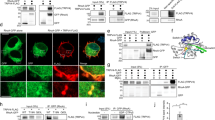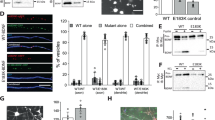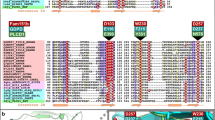Key Points
-
TUB is the founding member of the tubby-like proteins, or TULPs. TULPs are found in multicellular organisms from both the plant and animal kingdoms, which indicates an ancient and fundamental function.
-
The TULP family of proteins has neuronal expression patterns in the retina and cochlea, and throughout the brain. TULPs have been shown to have a role in obesity, sensoneuronal degeneration, and development; and ablation of certain TULPs has been shown to be responsible for obesity and retinitis pigmentosa.
-
The TULPs are characterized by a highly conserved domain of about 260 amino acids — the 'tubby' domain — which is located at the carboxyl terminus of all TULP-family proteins.
-
The tubby domain has been shown to bind double-stranded DNA, and certain amino-terminal splice forms of the mouse TUB protein have been shown to activate transcription. Furthermore, the TUB protein has been shown to localize to both the cell membrane and the nucleus. These data have led to the hypothesis that TULPs might function in transcription.
-
Compelling evidence shows that TULPs respond to signals from activated heterotrimeric G-proteins of the Gαq/11 family, which function through a phospholipase-Cβ-dependent pathway to mediate translocation of TUB from the plasma membrane to the nucleus.
-
Other evidence also implicates TUB in neuronal synapse function, and rhodopsin transport. This variety of seemingly disparate results, when reconciled, might place TULPs at a central point in the integration of a number of cellular signals.
Abstract
The tubby mouse, which shows late-onset obesity and neurosensory deficits, arises from a mutation in the Tub gene. Tub shares homology with the genes for tubby-like proteins Tulp1, Tulp2 and Tulp3. Ablation of Tub, Tulp1 or Tulp3 causes disease phenotypes that are indicative of their importance in nervous-system function and development. Despite this importance, the biochemical functions of tubby-like proteins are only now beginning to be understood. At present, data indicate that tubby-like proteins might function as heterotrimeric-G-protein-responsive intracellular signalling factors, although an array of data also implicates them in other processes.
This is a preview of subscription content, access via your institution
Access options
Subscribe to this journal
Receive 12 print issues and online access
$189.00 per year
only $15.75 per issue
Buy this article
- Purchase on Springer Link
- Instant access to full article PDF
Prices may be subject to local taxes which are calculated during checkout






Similar content being viewed by others
References
Coleman, D. L. & Eicher, E. M. Fat (fat) and tubby (tub): two autosomal recessive mutations causing obesity syndromes in the mouse. J. Hered. 81, 424–427 (1990).
Kleyn, P. W. et al. Identification and characterization of the mouse obesity gene tubby: a member of a novel gene family. Cell 85, 281–290 (1996).
Noben-Trauth, K., Naggert, J. K., North, M. A. & Nishina, P. M. A candidate gene for the mouse mutation tubby. Nature 380, 534–538 (1996). References 2 and 3 identify and characterize the Tub gene.
North, M. A., Naggert, J. K., Yan, Y., Noben-Trauth, K. & Nishina, P. M. Molecular characterization of TUB, TULP1, and TULP2, members of the novel tubby gene family and their possible relation to ocular diseases. Proc. Natl Acad. Sci. USA 94, 3128–3133 (1997).
Heikenwalder, M. F. et al. Molecular cloning, expression and regulation of the avian tubby-like protein 1 (tulp1) gene. Gene 273, 131–139 (2001).
Nishina, P. M., North, M. A., Ikeda, A., Yan, Y. & Naggert, J. K. Molecular characterization of a novel tubby gene family member, TULP3, in mouse and humans. Genomics 54, 215–220 (1998).
He, W. et al. GFP-tagged expression and immunohistochemical studies to determine the subcellular localization of the tubby gene family members. Brain Res. Mol. Brain Res. 81, 109–117 (2000).
Ronshaugen, M. et al. Structure and expression patterns of Drosophila TULP and TUSP, members of the tubby-like gene family. Mech. Dev. 117, 209–215 (2002).
Ikeda, S. et al. Retinal degeneration but not obesity is observed in null mutants of the tubby-like protein 1 gene. Hum. Mol. Genet. 9, 155–163 (2000).
Hagstrom, S. A., Duyao, M., North, M. A. & Li, T. Retinal degeneration in tulp1−/− mice: vesicular accumulation in the interphotoreceptor matrix. Invest. Ophthalmol. Vis. Sci. 40, 2795–2802 (1999).
Ikeda, A., Ikeda, S., Gridley, T., Nishina, P. M. & Naggert, J. K. Neural tube defects and neuroepithelial cell death in Tulp3 knockout mice. Hum. Mol. Genet. 10, 1325–1334 (2001).
Santagata, S. et al. G-protein signaling through tubby proteins. Science 292, 2041–2050 (2001). Shows the mechanism of Tub localization and translocation, as well as its connection to G-protein-coupled receptors.
Ikeda, S. et al. Cell-specific expression of tubby gene family members (tub, Tulp1, 2 and 3) in the retina. Invest. Ophthalmol. Vis. Sci. 40, 2706–2712 (1999).
Stubdal, H. et al. Targeted deletion of the tub mouse obesity gene reveals that tubby is a loss-of-function mutation. Mol. Cell. Biol. 20, 878–882 (2000).
Kapeller, R. et al. Tyrosine phosphorylation of tub and its association with Src homology 2 domain-containing proteins implicate tub in intracellular signaling by insulin. J. Biol. Chem. 274, 24980–24986 (1999).
Ikeda, A. et al. Microtubule-associated protein 1A is a modifier of tubby hearing (moth1). Nature Genet. 30, 401–405 (2002). Shows that the Tub cochlear-degeneration phenotype requires the BL6 allele of Map1a , and establishes a genetic interaction between Tub and proteins associated with synaptic function.
Gu, S. et al. Tubby-like protein-1 mutations in autosomal recessive retinitis pigmentosa. Lancet 351, 1103–1104 (1998).
Ohlemiller, K. K. et al. The murine tub (rd5) mutation is not associated with a primary axonemal defect. Cell Tissue Res. 291, 489–495 (1998).
Ohlemiller, K. K. et al. Cochlear and retinal degeneration in the tubby mouse. Neuroreport 6, 845–849 (1995).
Ikeda, A., Naggert, J. K. & Nishina, P. M. Genetic modification of retinal degeneration in tubby mice. Exp. Eye Res. 74, 455–461 (2002).
McMinn, J. E., Baskin, D. G. & Schwartz, M. W. Neuroendocrine mechanisms regulating food intake and body weight. Obes. Rev. 1, 37–46 (2000).
Guan, X. M., Yu, H. & Van der Ploeg, L. H. Evidence of altered hypothalamic pro-opiomelanocortin/neuropeptide Y mRNA expression in tubby mice. Brain Res. Mol. Brain Res. 59, 273–279 (1998).
Hagstrom, S. A., North, M. A., Nishina, P. L., Berson, E. L. & Dryja, T. P. Recessive mutations in the gene encoding the tubby-like protein TULP1 in patients with retinitis pigmentosa. Nature Genet. 18, 174–176 (1998).
Forrest, D. The erbA/thyroid hormone receptor genes in development of the central nervous system. Semin. Cancer Biol. 5, 167–176 (1994).
Freake, H. C. & Oppenheimer, J. H. Thermogenesis and thyroid function. Annu. Rev. Nutr. 15, 263–291 (1995).
Koritschoner, N. P. et al. Thyroid hormone regulates the obesity gene tub. EMBO Rep. 2, 499–504 (2001).
Seeley, R. J. & Schwartz, M. W. Neuroendocrine regulation of food intake. Acta Paediatr. Suppl. 88, 58–61 (1999).
Heckenlively, J. R. et al. Mouse model for Usher syndrome: linkage mapping suggests homology to Usher type I reported at human chromosome 11p15. Proc. Natl Acad. Sci. USA 92, 11100–11104 (1995).
Ikeda, A. et al. Genetic modification of hearing in tubby mice: evidence for the existence of a major gene (moth1) which protects tubby mice from hearing loss. Hum. Mol. Genet. 8, 1761–1767 (1999).
Ohlemiller, K. K. et al. Progression of cochlear and retinal degeneration in the tubby (rd5) mouse. Audiol. Neurootol. 2, 175–185 (1997).
Thomas, U. et al. Synaptic targeting and localization of discs-large is a stepwise process controlled by different domains of the protein. Curr. Biol. 10, 1108–1117 (2000).
Brenman, J. E. et al. Localization of postsynaptic density-93 to dendritic microtubules and interaction with microtubule-associated protein 1A. J. Neurosci. 18, 8805–8813 (1998).
Migaud, M. et al. Enhanced long-term potentiation and impaired learning in mice with mutant postsynaptic density-95 protein. Nature 396, 433–439 (1998).
Hagstrom, S. A. et al. A role for the Tubby-like protein 1 in rhodopsin transport. Invest. Ophthalmol. Vis. Sci. 42, 1955–1962 (2001).
Kikuchi, T., Arai, J., Shibuki, H., Kawashima, H. & Yoshimura, N. Tubby-like protein 1 as an autoantigen in cancer-associated retinopathy. J. Neuroimmunol. 103, 26–33 (2000).
Sahly, I. et al. Prominent neuronal-specific tub gene expression in cellular targets of tubby mice mutation. Hum. Mol. Genet. 7, 1437–1447 (1998).
Boggon, T. J., Shan, W. S., Santagata, S., Myers, S. C. & Shapiro, L. Implication of tubby proteins as transcription factors by structure-based functional analysis. Science 286, 2119–2125 (1999). This article shows the structure of the carboxyl terminus of the Tub protein and gives evidence of its possible role as a transcription factor.
Sadowski, I., Ma, J., Triezenberg, S. & Ptashne, M. GAL4–VP16 is an unusually potent transcriptional activator. Nature 335, 563–564 (1988).
Flier, J. S. & Maratos-Flier, E. Obesity and the hypothalamus: novel peptides for new pathways. Cell 92, 437–440 (1998).
Erickson, J. C., Clegg, K. E. & Palmiter, R. D. Sensitivity to leptin and susceptibility to seizures of mice lacking neuropeptide Y. Nature 381, 415–421 (1996).
Szczypka, M. S. et al. Feeding behavior in dopamine-deficient mice. Proc. Natl Acad. Sci. USA 96, 12138–12143 (1999).
Tecott, L. H. et al. Eating disorder and epilepsy in mice lacking 5-HT2c serotonin receptors. Nature 374, 542–546 (1995).
Chen, A. S. et al. Inactivation of the mouse melanocortin-3 receptor results in increased fat mass and reduced lean body mass. Nature Genet. 26, 97–102 (2000).
Huszar, D. et al. Targeted disruption of the melanocortin-4 receptor results in obesity in mice. Cell 88, 131–141 (1997).
Ohki-Hamazaki, H. et al. Mice lacking bombesin receptor subtype-3 develop metabolic defects and obesity. Nature 390, 165–169 (1997).
Jian, X. et al. The bombesin receptor subtypes have distinct G protein specificities. J. Biol. Chem. 274, 11573–11581 (1999).
Saito, Y. et al. Molecular characterization of the melanin-concentrating-hormone receptor. Nature 400, 265–269 (1999).
Wang, H. Y., Undie, A. S. & Friedman, E. Evidence for the coupling of Gq protein to D1-like dopamine sites in rat striatum: possible role in dopamine-mediated inositol phosphate formation. Mol. Pharmacol. 48, 988–994 (1995).
Hartman, J. I. & Northup, J. K. Functional reconstitution in situ of 5-hydroxytryptamine2c (5HT2c) receptors with αq and inverse agonism of 5HT2c receptor antagonists. J. Biol. Chem. 271, 22591–22597 (1996).
Leibowitz, S. F. & Alexander, J. T. Hypothalamic serotonin in control of eating behavior, meal size, and body weight. Biol. Psychiatry 44, 851–864 (1998).
Nonogaki, K., Strack, A. M., Dallman, M. F. & Tecott, L. H. Leptin-independent hyperphagia and type 2 diabetes in mice with a mutated serotonin 5-HT2C receptor gene. Nature Med. 4, 1152–1156 (1998).
Nishina, P. M., Lowe, S., Wang, J. & Paigen, B. Characterization of plasma lipids in genetically obese mice: the mutants obese, diabetes, fat, tubby, and lethal yellow. Metabolism 43, 549–553 (1994).
Julius, D., MacDermott, A. B., Axel, R. & Jessell, T. M. Molecular characterization of a functional cDNA encoding the serotonin 1c receptor. Science 241, 558–564 (1988).
Ashrafi, K. et al. Genome-wide RNAi analysis of Caenorhabditis elegans fat regulatory genes. Nature 421, 268–272 (2003). A tour-de-force of worm genetics, and a significant undertaking producing valuable data for those working on metabolism and obesity from metazoans to humans.
Acknowledgements
We thank S. Patel and K. Simpson for critical reading of the manuscript. This work was supported by a grant from the American Diabetes Association and the National Institutes of Health.
Author information
Authors and Affiliations
Corresponding author
Ethics declarations
Competing interests
The authors declare no competing financial interests.
Related links
Related links
DATABASES
LocusLink
OMIM
Interpro
Swiss-Prot
corticotropin-releasing hormone
Glossary
- COCHLEAR ORGAN OF CORTI
-
A complex epithelial structure in the cochlea that rests on the internal surface of the basilar membrane, and in mammals is the main part of the ear that directly perceives sound.
- INSULIN RESISTANCE
-
An animal is said to be insulin resistant if abnormally high insulin levels are required to elicit typical physiological effects, such as lowering glucose levels in the bloodstream.
- HETEROTRIMERIC G-PROTEIN
-
A protein complex of three proteins (Gα, Gβ and Gγ). Whereas Gβ and Gγ form a tight complex, Gα is part of the complex in its inactive, GDP-bound, form but dissociates in its active, GTP-bound, form. Both Gα and Gβγ can transmit downstream signals after activation.
- RETINITIS PIGMENTOSA
-
Any of several hereditary, progressive, degenerative diseases of the eye that are marked by night blindness in the early stages, atrophy and pigment changes in the retina, constriction of the visual field, and eventual blindness.
- ELECTRORETINOGRAPHY
-
A method for measuring changes in the electrical potential of the retina when it is stimulated by light.
- ROD PHOTORECEPTOR CELLS
-
Columnar cells (about 40 μm long and 1 μm wide) that have three distinct regions: a region adjacent to (and synapsed with) the neural layer of the retina contains the nucleus and other cytoplasmic organelles; below this is the inner segment, which is rich in mitochondria; this, in turn, is connected through a thin neck (in which a ciliary body is located) to the outer segment.
- CONE PHOTORECEPTOR CELLS
-
Cone-shaped cells of the vertebrate retina, which, in mammals, contain the photopigment iodopsin. Human cone cells are thought to occur in three types, which contain iodopsins of different spectral sensitivities. Therefore, they are thought to be responsible for colour vision.
- CONE-ROD DYSTROPHY
-
An inherited, progressive disease that causes deterioration of the cone and rod photoreceptor cells and often results in blindness. It can be found as an autosomal-dominant trait, but it is usually acquired in an autosomal-recessive way. It is similar to retinitis pigmentosa in this way, but does not cause loss of night vision, although rod and cone degeneration is equivalent.
- TRANSVERSION
-
A point mutation in which a purine base is substituted for a pyrimidine base and vice versa.
- ARCUATE NUCLEUS
-
A nucleus located in the middle hypothalamus in the most ventral part of the third ventricle near the entrance of the infundibular recess.
- PHALANGEAL CELLS
-
Cells of the organ of Corti (in the inner ear).
- GANGLION CELL
-
A type of interneuron that conveys information from the retinal bipolar, horizontal and amacrine cells to the brain.
- SUPPORT CELLS
-
Cells that completely surround the inner hair cells. The physiological function of the several supporting cell types of the organ of Corti, such as Hensen's cells, Deiters' cells, border cells, and inner phalangeal cells, is obscure.
- EXENCEPHALY
-
A condition in which the skull is defective, with the brain extruding.
- ACID-GLOBULE ACTIVATION DOMAIN
-
A protein domain that is rich in acidic amino acids and is known to activate transcription. It is commonly found in transcription factors.
- HYPERINSULINAEMIA
-
An endocrine disorder that is characterized by a failure of the blood-sugar control system to work properly, and occurs when insulin progressively loses its effectiveness in removing the blood glucose from the bloodstream.
- PC12 CELLS
-
A clonal line of rat adrenal pheochromocytoma cells that respond to nerve growth factor and can synthesize, store and secrete catecholamines in a similar way to sympathetic neurons. PC12 cells contain small, clear, synaptic-like vesicles and larger, dense-core granules.
- SH2 DOMAIN
-
(Src-homology-2 domain). A protein motif that recognizes and binds tyrosine-phosphorylated sequences, and thereby has a key role in relaying cascades of signal transduction.
Rights and permissions
About this article
Cite this article
Carroll, K., Gomez, C. & Shapiro, L. Tubby proteins: the plot thickens. Nat Rev Mol Cell Biol 5, 55–64 (2004). https://doi.org/10.1038/nrm1278
Issue Date:
DOI: https://doi.org/10.1038/nrm1278
This article is cited by
-
Whole-genome and dispersed duplication, including transposed duplication, jointly advance the evolution of TLP genes in seven representative Poaceae lineages
BMC Genomics (2023)
-
Tubby-like Protein 2 regulates homogalacturonan biosynthesis in Arabidopsis seed coat mucilage
Plant Molecular Biology (2019)
-
Molecular pathogenesis of interstitial cystitis based on microRNA expression signature: miR-320 family-regulated molecular pathways and targets
Journal of Human Genetics (2018)
-
Primary cilia proteins: ciliary and extraciliary sites and functions
Cellular and Molecular Life Sciences (2018)
-
Tubby is required for trafficking G protein-coupled receptors to neuronal cilia
Cilia (2012)



